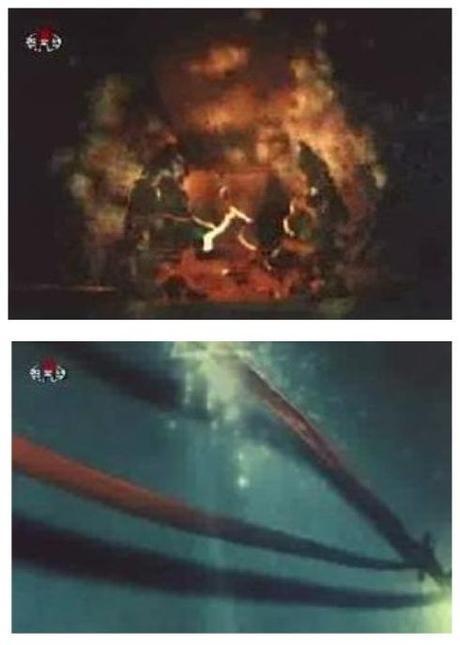![Imports and Exports Debris of the U'nha-3 rocket retrieved by South Korean [ROK] in late December 2012 (Photo: Yonhap)](https://m5.paperblog.com/i/40/406413/imports-and-exports-L-QebI7v.jpeg)
Debris of the U’nha-3 rocket retrieved by South Korean [ROK] in late December 2012 (Photo: Yonhap)
The United Nations Security Council [UNSC] continues to deliberate on its reaction to the DPRK’s 12 December 2012 launch of the U’nha-3 carrier rocket and the Kwangmyo’ngso’ng-3 [KMS-3] satellite. The rumors about the UN’s reaction disparate. Yonhap News Agency reported on 18 January (Friday) that the UNSC was” poised to adopt a new resolution calling for tougher sanctions against North Korea for its recent rocket launch” and citing unnamed sources who claimed “the move comes as China, a veto-wielding council member and a key ally of North Korea, apparently reversed its stance against taking strict actions against the North and agreed to punish Pyongyang.” KBS Global‘s English service, however, reported that the UNSC will make an announcement on Saturday (19 January) and citing another unnamed source “the U.S. and China have agreed to announce a presidential statement as early as Saturday strongly denouncing North Korea’s long-range rocket launch.”While the DPRK continues its dilatory opening policies and expands its foreign trade relationships, news items in South Korea [ROK] and Japanese media find foreign footprints in the DPRK’s strategic weapons program. On 16 January (Wednesday) Munhwa Ilbo reported that South Korea’s [ROK] preliminary investigation of the U’nha-3 debris retrieved during 26 to 27 December was most likely a patchwork of DPRK, Chinese, Russian and European components. According to Munhwa‘s unnamed source ”the aluminum alloy fuselage, pressure sensor for the control system and the electric wiring systems were imported from Russia, China or other nations with advanced missile technology.” Another unnamed official said that the U’nha-3′s rocket engine was “composed both of banned items and dual-use components.” In late December 2012 Aera reported that uranium enrichment centrifuges, which were produced inside the DPRK, were modeled after those manufactured by Urenco Group and and at a uranium enrichment facility in Rokkasho, Aomori in Japan. When a US group of nuclear experts toured a DPRK uranium enrichment facility in November 2010, a DPRK engineer told them “All components in this facility were produced domestically. But they were modeled after the centrifuges at Almelo and Rokkasho-mura.”

These images reportedly depict the DPRK’s May 2009 nuclear test. They appeared in an episode of the Korea Film Studios’ feature The Country I Saw, broadcast in September 2010, which included a depiction of the 2009 experimental detonation. (Photo: KCTV)
Almelo is a small city in the east of The Netherlands, and the location of a Urenco Group uranium enrichment facility (producing gas centrifuges for nuclear reactors). According to Aera Urenco’s facility in Almelo was the employer of the notorious Pakistani engineer and nuclear scientist Dr. Abdual Qadeer Khan and Dr. Khan’s work at that time is how he attained knowledge on uranium enrichment. How the DPRK attained technical knowledge from Japan’s facilities in Rokkasho is not clear. The facilities in Rokkasho extract plutonium and uranium from spent nuclear fuel from Japan’s nuclear power plants, and the Rokkasho complex contains its own uranium enrichment facility. Some external experts claim that the DPRK operated a network of experts and technicians who acquired the information from Japan and forwarded it back to the DPRK. Aera reported in 1998 that a senior party official remarked that “scientists and engineers in Japan are engaged in patriotic activities to make their socialist home country a rich and powerful state and to realize the unification of two Koreas.” The Japanese, for their part, issued a 2006 memorandum “to take caution against suspicious personnel.”
Filed under: 2nd Academy of Natural Science, Central Committee, Central Military Committee, critical infrastructure, DPRK Cabinet, DPRK External Relations, DPRK General Department of Atomic Energy, DPRK Intelligence Community, DPRK-United Nations Relations, gsd, gsob, Guard Command, Korea Committee for Space Technology, Korean People's Army (KPA), Korean Workers' Party (KWP), KPA construction battalions, KPA construction brigades, KPA General Political Bureau, KPA General Political Department, KPA General Staff, KPA General Staff Nuclear Chemical Bureau, KPA Large Combined Units, KPA Strategic Rocket Force Command, Kwangmyongsong-3, KWP Science and Education Department, Machine Building Industry Department, military security command [msc], Ministry of State Security, Ministry of the People's Armed Forces (MPAF), MPAF GPB, National Academy of Defense Sciences, National Defense Commission (NDC), NDC Administration Department, NDC Policy Department, nuclear weapons, Organization and Guidance Department, Political Bureau, Second Economic Committee, Second Economy Commission, Secretariat, Six Party Talks, Sohae Space Launching Station, Supreme People's Assembly, Unha-3 Carrier Rocket
